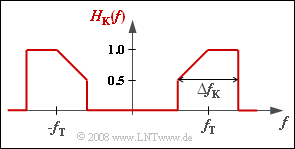Exercise 1.10: BPSK Baseband Model
In this exercise, we consider a BPSK system with coherent demodulation, i.e.
- $$s(t) \ = \ z(t) \cdot q(t),$$
- $$b(t) \ = \ 2 \cdot z(t) \cdot r(t) .$$
The designations chosen here are based on the block diagram in the theory section.
The influence of a channel frequency response $H_{\rm K}(f)$ can be taken into account in a simple way if it is described together with modulator and demodulator by a common baseband frequency response:
- $$H_{\rm MKD}(f) = {1}/{2} \cdot \big [ H_{\rm K}(f-f_{\rm T}) + H_{\rm K}(f+f_{\rm T})\big ] .$$
- Thus the modulator and demodulator are virtually shortened against each other, and
- the bandpass channel $H_{\rm K}(f)$ is transformed into the lowpass range.
The resulting transmission function $H_{\rm MKD}(f)$ should not be confused with the lowpass transmission function $H_{\rm K, \, TP}(f)$ as described in the chapter Equivalent Low-Pass Signal and its Spectral Function of the book "Signal Representation", which results from $H_{\rm K}(f)$ by truncating the components at negative frequencies as well as a frequency shift by $f_{\rm T}$ to the left.
For frequency responses, in contrast to spectral functions, the doubling of the components at positive frequencies must be omitted.
Notes:
- The exercise belongs to the chapter Linear Digital Modulation - Coherent Demodulation.
- Reference is made in particular to the section Baseband model for ASK and BPSK.
Questions
Solution
- $H_{\rm K,TP}(f)$ results from $H_{\rm K}(f)$ by cutting off the negative frequency components and shifting $f_{\rm T}$ to the left.
- For frequency responses – in contrast to spectra – the doubling of the components at positive frequencies is omitted. Therefore:
- $$H_{\rm K,\hspace{0.04cm} TP}(f= 0) = H_{\rm K}(f= f_{\rm T})=1.$$
- Because of the real and asymmetrical spectral functions $H_{\rm K,\hspace{0.04cm}TP}(f)$ the corresponding time function (Fourier inverse transform) $h_{\rm K,\hspace{0.04cm}TP}(t)$ is complex according to the allocation theorem.
(2) Here only the third proposed solution is correct:
- The spectral function $H_{\rm MKD}(f)$ always has an even real part and no imaginary part. Consequently $h_{\rm MKD}(t)$ is always real.
- If $H_{\rm K}(f)$ had additionally an imaginary part odd by $f_{\rm T}$, $H_{\rm MKD}(f)$ would have an imaginary part odd by $f = 0$. Thus $h_{\rm MKD}(t)$ would still be a real function.
The diagram illustrates the differences between $H_{\rm K,\hspace{0.04cm}TP}(f)$ and $H_{\rm MKD}(f)$. The parts of $H_{\rm MKD}(f)$ in the range around $\pm 2f_{\rm T}$ need not be considered further.
(3) $H_{\rm MKD}(f)$ is additively composed of a rectangle and a triangle, each with width $\Delta f_{\rm K}$ and height $0.5$. It follows:
- $$h_{\rm MKD}(t) = \frac{\Delta f_{\rm K}}{2} \cdot {\rm si} (\pi \cdot \Delta f_{\rm K} \cdot t)+ \frac{\Delta f_{\rm K}}{4} \cdot {\rm si}^2 (\pi \cdot \frac{\Delta f_{\rm K}}{2} \cdot t)$$
- $$ \Rightarrow \hspace{0.3cm}h_{\rm MKD}(t = 0) = \frac{\Delta f_{\rm K}}{2} + \frac{\Delta f_{\rm K}}{4} = 0.75 \cdot \Delta f_{\rm K}\hspace{0.3cm} \Rightarrow \hspace{0.3cm}h_{\rm MKD}(t = 0)/{\Delta f_{\rm K}} \hspace{0.1cm}\underline {= 0.75} .$$
(4) The second proposed solution is correct:
- The first si function does have equidistant zero crossings at the distance $1/\Delta f_{\rm K}$.
- But the equidistant zero crossings of the whole time function $h_{\rm MKD}$ are determined by the second term:
- $$h_{\rm MKD}(t = \frac{1}{\Delta f_{\rm K}}) = \ \frac{\Delta f_{\rm K}}{2} \cdot {\rm si} (\pi )+ \frac{\Delta f_{\rm K}}{4} \cdot {\rm si}^2 (\pi/2) = \frac{\Delta f_{\rm K}}{4},$$
- $$h_{\rm MKD}(t = \frac{2}{\Delta f_{\rm K}}) = \ \frac{\Delta f_{\rm K}}{2} \cdot {\rm si} (2\pi )+ \frac{\Delta f_{\rm K}}{4} \cdot {\rm si}^2 (\pi) = 0.$$

